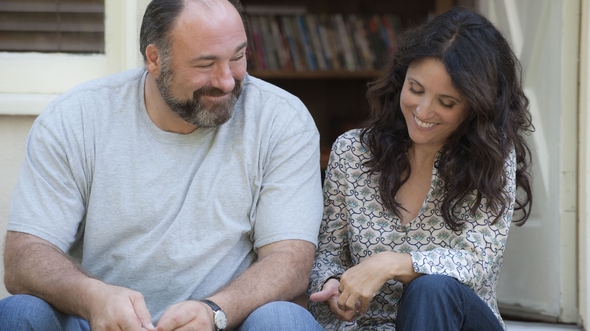We’ve all seen love
stories on the big screen, The Notebook,
Titanic and Romeo and Juliet are a few examples that come to mind, so the basic
premise of Enough Said is nothing
new. But what I found so refreshing was witnessing two mature adults at similar
points in their lives have a meaningful and beautiful relationship with each
other. And on top of this, it was nice to see a male lead like the late great
Gandolfini, a man who did not have the appearance of the typical Hollywood
‘leading man’. Nevertheless, his character in Enough Said highlights the basic fact that it is not a persons
looks, weight or age that impacts their ability to engage in a meaningful
romantic relationship with another person, rather it is (get ready for a
cliché) who they are on the inside.
Of course Enough Said didn’t teach me this
important message, but it was great to see it on the big screen presented in a
non-preachy, realistic way. Essentially the film, like any other love story,
tells the story of two people who fall in love with each other, but the writing,
casting and performances made it original, exciting and refreshing to watch.
Louis-Dreyfus and Gandolfini in Enough Said
I also recently
finished season 1 of the Netflix series
Orange is the New Black, which I
would say is a must watch for anyone who is a fan of good television and anyone
who is human. Orange is the New Black
(OITNB) is full of refreshing portrayals of characters, primarily women, and I
believe it’s overwhelming success can be partly attributed to this fact. Here
are a few examples:
- It has one of the most racially diverse casts on television today, and even though there has been discussion about how certain racial elements are portrayed, the show has to be given credit for it’s inclusion of a vast array of African American, Hispanic, Latina, Asian and Caucasian characters.
- Women absolutely dominate the show, not just in quantity but in character structure and storylines as well. The female inmates especially are different ages, from different circumstances, and have different physical appearances that are very unique in a media world that places great emphasis on “conventional” beauty (whatever that is) and having a certain body type.
- It displays a range of different sexualities without binary labels and I believe The Huffington Post’s Amanda Duberman highlights this perfectly,
The series' most heavy-handed moments relate to sexuality. "You
don't just turn gay," Piper insists to her friend and fiance, "you
fall somewhere on a spectrum, like a Kinsey scale." Still, that the show
doesn't insist on a sexuality binary is perhaps its most evolved achievement.
Some inmates identify as lesbians, some as bisexuals, and some as women who are
in prison and still want to have sex … All of it is a stunningly nuanced
promotion of sex and gender fluidity -- especially impressive for a show whose
chief project isn't necessarily to provide it.
So what is my point exactly? The point I am
trying to make is that we are living in a society that is at a point where
unoriginal ideas and characters in film and television are just not sufficient
enough.
The Cast of Orange is the New Black



No comments:
Post a Comment